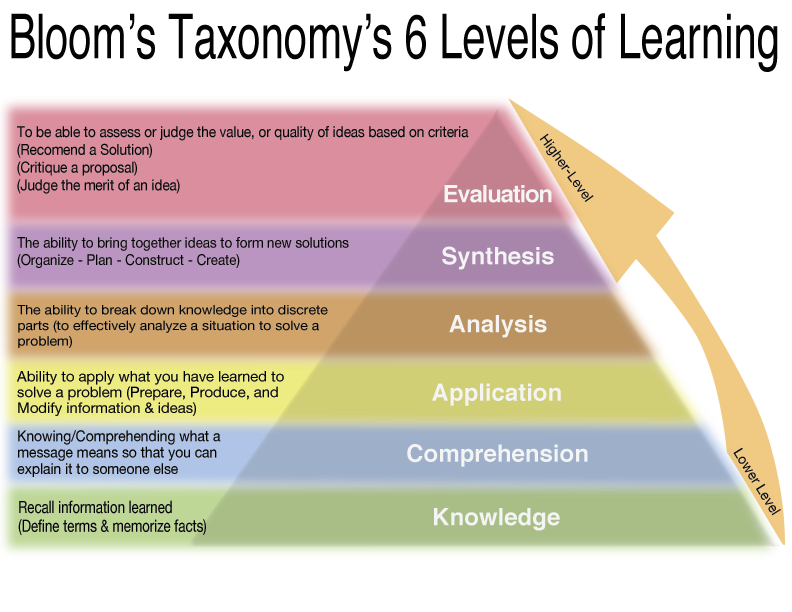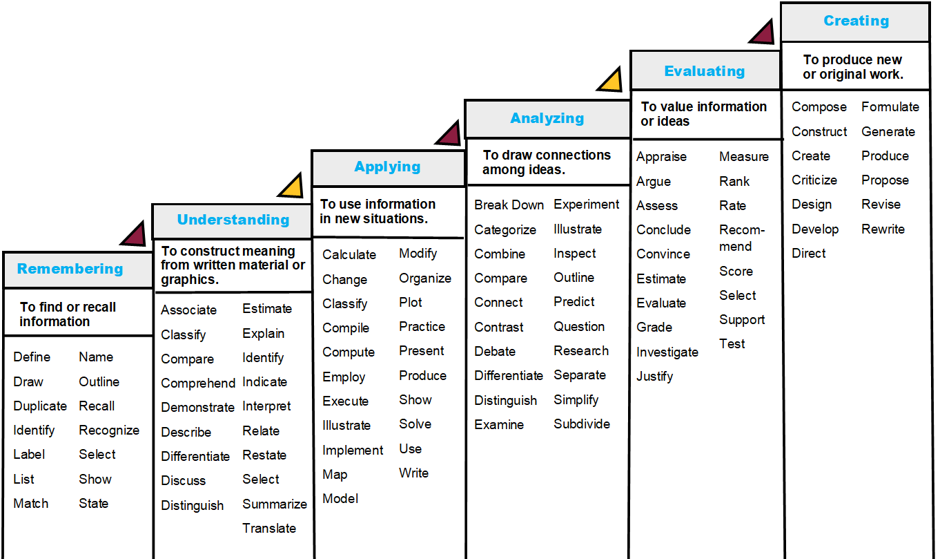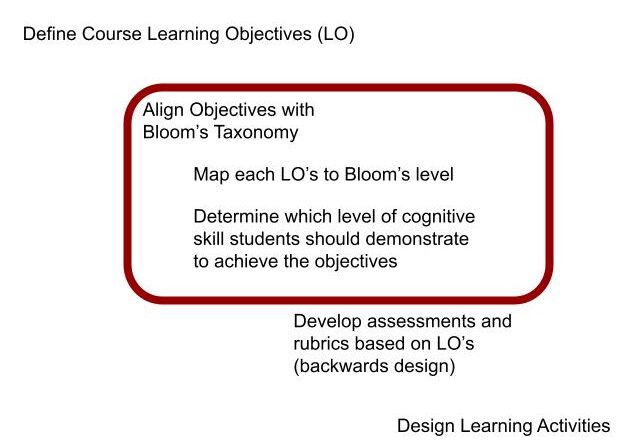Bloom’s Taxonomy
 Overview and Introduction: The WHAT and WHO
Overview and Introduction: The WHAT and WHO
Bloom’s Taxonomy is a framework for categorizing educational goals based upon the cognitive effort required to accomplish it. It was originally published in 1956 by Benjamin Bloom, Max Englehart, Edward Furst, Walter Hill, and David Krathwohl [3]. The framework is most commonly represented as a triangle with six distinct layers with each layer requiring more effort than the one below it. The original taxonomy’s six layers, starting from the base are Knowledge, Comprehension, Application, Analysis, Synthesis, and Evaluation.
In 2001, a group of cognitive psychologists, instructional researchers, assessment specialists, and curriculum theorists published a revised version of the taxonomy. The authors made two major edits. They changed the category names from nouns to verbs (or gerunds), moving it from a passive to an active framework. They also swapped the top two layers making Creation the main goal of learning. The revised taxonomy reads – Remember, Understand, Apply, Analyze, Evaluate, and Create.
It is helpful to think of the taxonomy as a spectrum that spans from Lower Order Thinking Skills (LOTS) to Higher Order Thinking Skills (HOTS). The bottom three layers (Remember, Understand, and Apply) are often thought of as Lower Order Thinking Skills. The top three layers (Analyze, Evaluate, and Create) are considered Higher Order Thinking Skills. Viewing the framework through this lens can assist faculty and students in pushing the requirements of an effective learning experience.
Objectives are important in establishing a common definition of expectations between faculty and students. Clearly defined and organized objectives, with action words, help lay out the visible actions students should take to demonstrate their learning.
Bloom’s Taxonomy assists Instructors by:
-
-
- Giving a framework for the planning and delivering appropriate instruction.
- Ensuring the design of valid assessment strategies and tasks.
- Encouraging the alignment of assessment and instruction.
-
Bloom’s Taxonomy assists Students by:
-
-
- Clearly conveying what a student is expected to be able to DO by the end of a given unit of instruction.
- Acting as a self-assessment checklist for students once a unit of instruction is completed.
- Assisting students in understanding how they will be evaluated by the instructor.
-
Bloom’s Taxonomy assists Programs/Institutions by:
-
-
- Helping generate documentation for accreditation.
- Assisting with vertical course and program alignment.
- Articulating outcomes of the program/institution to prospective students.
-

 Implementation and Timing: The WHEN, WHERE, and HOW
Implementation and Timing: The WHEN, WHERE, and HOW
Bloom’s taxonomy can be a powerful tool, especially if leveraged in the early planning stages of instruction. Setting concrete outcomes using clear action oriented words at the start of any course/unit/module/daily lesson plan can simplify the process of designing and developing instruction. It helps to focus efforts on essential knowledge and skills that need to be achieved.
For example:
Bloom’s vocabulary can be used in various places in a course and its instruction. Common places where instructors want clearly defined objectives are the course syllabus, assignment details, rubrics, and lecture/lesson introductions. Connecting the action words from Bloom’s taxonomy in creating rubrics for assessments is an ideal example of where faculty can further higher order thinking for students.
For example: A learning objective for a civil engineering course is revised in the table below.
| Remembering (Typical learning objective) | Analyzing (Elevated learning objective) |
| “Recall the basic principles of bridge design, such as the types of materials used and the load-bearing capacity of different structures” | “Analyze the strengths and weaknesses of different bridge designs, and make informed decisions about which design is most suitable for a particular situation” |
One of the best ways to leverage the power of Bloom’s Taxonomy is to implement a Backwards Design approach to course design and development. Starting with the end in mind, faculty can transform a typical learning objective into something more robust by applying Bloom’s taxonomy. ASUonline’s objective builder [4] is a great way to get started thinking about what students should be able to do by the end of this course, module, or lesson. Once instructors have the endpoint, they can reverse engineer the path to get there. If, for example, the objective is for students to be able to apply an entrepreneurial mindset (EM) to their own studies, an assessment that might be able to prove that they were successful in this might be a personal reflection statement or a discussion among peers. The learning materials that would support that assessment might be a reading or video with an explanation of the elements of EM and examples of how an engineer would benefit from such a mindset.

 Rationale and Research: The WHY
Rationale and Research: The WHY
When students can view the tasks they must perform to reach their end goals, their motivation and ability to accomplish those goals is increased. Ideally lesson level goals scaffold the module/unit objectives which in turn support the course level objectives. When all of these can clearly be tied into program level outcomes it becomes easier for all to see the value in the program and instruction. Assessments may be difficult but not surprising to students. They will see assessments as opportunities to show they can perform the pre-defined objectives. When those objectives have relevance to industry and the real world, they are even that much more prepared to promote themselves in the job market.
In a research study with 213 computer science students [6], the most optimal pathway for student success involved following the cognitive pathway through Bloom’s taxonomy of learning. Specific to their study, researchers found significant statistical impact that each level of Bloom’s had to the next sequential higher order thinking level and insignificant impact when going up non-sequential levels.
Another study showed that students’ satisfaction with the instructor and course jumped significantly just by using Bloom’s taxonomy to clarify instructions, assignments/tasks, and description of learning objectives. “The users of the course will have a feeling that they are guided in a well-structured manner and that their guide knows the journey very well [7].”

 Additional Resources and References
Additional Resources and References
[1] T. Smith. “Writing Measurable Learning Objectives.” Teach Online. Accessed: Dec 21, 2022. [Online]. Available: https://teachonline.asu.edu/2012/07/writing-measurable-learning-objectives/
[2] “Bloom’s Taxonomy.” University Office of Evaluation and Educational Effectiveness. Accessed: Dec 21, 2022. [Online]. Available: https://uoeee.asu.edu/blooms-taxonomy
[3] B. S. Bloom, Taxonomy of educational objectives: The classification of educational goals. London: Longman Group, 1956.
[4] “Learning Objectives Builder.” Teach Online. Accessed: Dec 21, 2022. [Online]. Available: https://teachonline.asu.edu/objectives-builder/
[5] O. Sneed. “Integrating Technology with Bloom’s Taxonomy.” Teach Online. Accessed: Dec 21, 2022. [Online]. Available: https://teachonline.asu.edu/2016/05/integrating-technology-blooms-taxonomy/
[6] Z. Ullah, A. Lajis, M. Jamjoom, A. Altalhi, and F. Saleem, “Bloom’s taxonomy: A beneficial tool for learning and assessing students’ competency levels in computer programming using empirical analysis,” Comput. Appl. Eng. Educ., vol. 28, no. 6, pp. 1628–1640, Nov. 2020, doi: 10.1002/cae.22339.
[7] M. Pikhart and B. Klimova, “Utilization of Linguistic Aspects of Bloom’s Taxonomy in Blended Learning,” Educ. Sci., vol. 9, no. 3, p. 235, Sep. 2019, doi: 10.3390/educsci9030235.


